Xie Rong, Artist and ideaXme Eco Art Ambassador interviews Betsy Damon Artist, Environmental Activist and Founder, Keepers of the Waters. Please scroll down for the complete transcript of the interview.
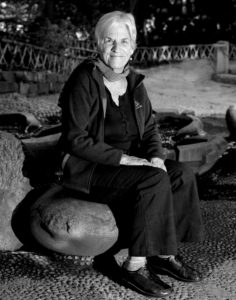
A journey with water
The supreme goodness is like water.
It benefits all things without contention.
In dwelling, it stays grounded.
In being, it flows to depths.
In expression, it is honest.
In confrontation, it stays gentle.
In governance, it does not control.
In action, it aligns to timing.
It is content with its nature and therefore cannot be faulted.
Chinese philosopher Lao Zi, 6th-century BC, Tao Te Ching.
Xie Rong comments:
On researching and interviewing Betsy Damon, I have concluded that she is water!
Betsy Damon was my childhood hero. Her design The Living Water Garden is a mini wetland heaven in the middle of my hometown ChengDu. It is a free public park that demonstrates how water cleans itself.
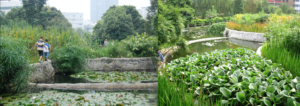
From 1995 to1996, Betsy directed two public art events in ChengDu and Tibet that fundamentally changed the government’s as well as general public’s understanding about performance art. Furthermore, it was a groundbreaking moment that introduced rising stars in Chinese contemporary art. Despite worldwide acclaim, Betsy has remained modest about her art. After decades of work as an artist, she continues to exhibit her work.
As the first generation of Eco feminist artists, Betsy chooses to give her life, time and efforts to real water and to build art to inspire the community. From her gritty 1977 performance in Wall Street, to her large collection of drawings, etchings and video art we see honesty and purity. We witness time and motion! This is art the people of the world should celebrate! Here is a story of a woman who discovered the importance of water. Her journey with water inspires the audience to reflect on our relationship with nature. It draws us from the material world and ego to the art community and selfless activism. It helps us to realise the power of community and the collective mind! This journey is even more important in today’s COVID isolated world. Betsy turned 80 on the 31st of Dec 2020. So, let’s all wish her a belated very healthy and happy birthday! I truly hope you enjoy this interview. It’s hard to convey a lifetime of work in a 52 minute conversation but I hope that this serves as an introduction to Betsy’s life and an invitation to join the Keepers of the Waters!
Betsy Damon bio: Betsy Damon is an internationally recognised artist whose public work and living systems, such as the Living Water Garden, have received widespread acclaim. She directs Keepers of the Waters, a nonprofit focused on ecological planning, advocacy and education. Damon was a semi-finalist for the Buckminster Fuller Award and a finalist for the Stockholm Water Prize. Damon has lectured widely in the U.S, Europe and China. She’s been a visiting artist at countless colleges and universities.
Find the transcript of this interview below.
Betsy Damon and Xie Rong ECHO-eco ideaXme interview. Transcript created by ideaXme. Edited to make the conversation flow!
Xie Rong: [00:00:02] My name is Xie Rong. Welcome to the first episode of ECHO-eco, a series of interviews that are rooted in socially engaged ecological art. ECHO-eco is part of ideaXme, a program accessible in 40 countries across the world.
ideaXme, is a multimedia platform. It is a podcast, mentor program and creator series. The podcast showcases the work and human stories of creators and pioneers who shape our world. My very first guest, a hero from my childhood, is a prominent figure and trailblazer of the first generation of eco feminist artists.
From her gritty performance in New York City in the 1970s to designing the first city ecological park with water as its theme, just like water she flows and creates. There are many personas and movements funded under her name. The 7000-Year-Old Woman, Blind Beggar Woman, No Limits For Women Artists and The Keepers Of The Waters. Her life is so visual and eventful. Please join me on this journey with water. I will weave in my questions along the way.
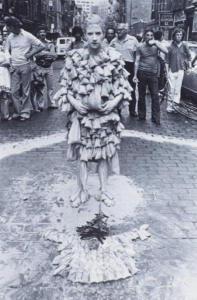
Xie Rong: [00:01:28] Hello, Betsy. It is such an honor to finally meet you online. Could you please introduce yourself to our audience and take us through your ‘life’s journey’? In your words, who are you?
Who is Betsy Damon?
Betsy Damon: [00:01:44] This is amazing. You already said who I am!
Betsy Damon: [00:01:59] I don’t really have those kinds of words. I’m a grandmother, I’m a mother, I’m in relationships with the waters and a great many people. What can I say? I just follow my path. I also very deeply believe that when we understand water, we can solve our problems. But we have to really know water. And not only do we have to know water, but when we know water, we could probably clean up this earth. I’m not the only person who says that, but I might be the only artist. . At the same time, I’m saying this for the first time, water is being traded on Wall Street. When we try to own the right to life and trade it for money that’s the ultimate destruction. Then, you know, equity, the right to life of everything, every person and every living system has just gone out the window. This is my passion. If I could wave a wand, I would make everybody claim their water. Everybody, let’s clean it up together worldwide!
People Healed Themselves And Others With Stones
Xie Rong: [00:03:42] Can you take our audience back to the time and place from where the passion grew? How did it flourish? Like we said, a lot of people know you from your early performance art on the street in New York City in the 1970’S. As a performance artist myself, I’m fascinated with the material you use, the words you write, the people with whom you have collaborated, and how you involved people interactively on the street. With stones, on the streets of SoHo, people healed each other and shared their stories. Could you tell us just a little bit more about what the art scene was like in the 1970s in New York? Were there many performance female artists like yourself? Did you feel you were in a group of people like yourself? Take us back to the 1970s, please.
Betsy Damon: [00:04:35] Well, you know, in the 1970s, I was just a young mom and I really thought that I had lost my way. So, I decided to find myself. You can’t do anything unless you have yourself, you really can’t. Your ideas stay in your mind and cannot go far. One step in finding myself was to teach a feminist art studio in Cornell. More importantly, I committed myself to making something out of what I dreamed. The 7000-Year-Old Woman was a dream, and it took me several years to complete the dream until I could perform her. I had two little children, one in a body cast, and there’s no time, no real time.
Xie Rong: [00:05:25] I read about the 7000-Year-Old Woman which looked at who this woman really was. I learned that you thought of her as: “She’s my mother. She’s my grandmother”. As if you suddenly heard your ancestors and your friends and all your female voices. And you said you begin to understand yourself through the performance. I think that sense of vulnerability was quite visible in your early performance.
Betsy Damon: [00:05:58] Yeah, well Mierle Ukeles was washing the sidewalk with her hair. So, I had a little company, but there were not a lot of women stepping out like that. There were a few, Donna Henes and Mierle Ukeles. I’m sure there’s a few others. then I just followed my dreams. I asked myself, who’s collecting the stories? So, then I did The Blind Beggar Woman to collect stories. I was being led to do these performances on Wall Street. My great grandfather or my grandfather had an office on Wall Street, and he kept asking, please, please, not Wall Street, not Wall Street. I rode my bicycle everywhere looking for somewhere to perform it. I decided, despite what my grandfather said, that the performance just had to be on Wall Street.
Xie Rong: [00:06:59] You were (and continue to be) also involved in a lot of community work and a lot of organizations with workshops. So not only were you performing as the performer, but you were also hosting exhibitions. You organized exhibitions and you were wrote. You were very much involved with the community.
Betsy Damon: [00:07:17] Yes, because I wanted company, and community was essential.
Xie Rong: [00:07:21] Were they also mothers or were just a lot of female artists who got together?
Betsy Damon: [00:07:26] All of the above. You can’t go very far by yourself. That’s an illusion. It’s an illusion under capitalism, especially in the United States, that as an individual you can succeed. That’s not true. Our successes are interdependent. I got artists together to write applications for grants and other things. So, rather than competing with each other, we helped each other.
Betsy Damon: [00:07:57] And then No Limits For Women Artists started in 1980, and that was all about forming your own support system. There were groups everywhere across the United States. I led leaders’ workshops. The most empowering thing is to have your own support system, so there’s somebody constantly saying to you: How’s it going? What’s next? What support do you need?
Xie Rong: [00:08:31] And that led you to have a road trip with a group of papermakers. That led to a different stage of your life where you recognised “water” as being the foundation of all life and of everything you wanted to do. Could you take us back to how this happened?
Betsy Damon: [00:08:55] I was doing these “healing with stones”, “breathing with stones” performances for the survival of the planet. And I did this every full moon in a gallery, but I also performed it on the streets several times. I was doing that at a big conference in Canada. There’s just a whole way that everybody, even as many as 400 people could heal each other and then think about what they would do for the planet. I had been learning papermaking with Coco Gordon, a paper maker and doing what I called Earth Skins.
Betsy Damon: [00:09:40] So I had been thinking. About “No limits” and the question: What if you have all the resources you need, what would you do? What’s the idea you’re dreaming of that you have not yet shared with anybody? What’s your highest imagination of doing?
Betsy Damon: [00:10:04] I ask students that now too: What would you love to do? And why don’t you do it? What’s stopping you? Some answer: There were some teachers who told me I had to do it this way. I have to do things this way to get credits.
Betsy Damon: [00:10:23] I shared an idea that I had. But I had the idea because I took my children camping across the United States for seven weeks. And I saw all these dry riverbeds and I hadn’t seen them as a child. As a child I also travelled across the United States. I asked these paper makers: What’s the biggest idea you’d like to do? There were five of us in this car. Then they turned around and asked me. First, I said: I can’t do it. And they said: Tell us nonetheless! I said: Well, I want to cast two hundred and fifty feet of a dry riverbed with handmade paper. They screeched to a stop. They said: We’ll help you do that!
Betsy Damon: [00:11:38] It was shown at the Thomas Erben Gallery that summer and got a lot of attention. And now I’m sending it to be repaired and maybe some place else will adopt it.
Betsy Damon: [00:11:47] That would be nice. That money could go towards all kinds of other projects.
Xie Rong: [00:11:54] So, that was 1985?
Betsy Damon: [00:11:57] That’s right.
Xie Rong: [00:11:58] I remember you said that there was a vivid moment when you cast the riverbed and you looked up at the Milky Way in the sky above. Tell us about that because it was just so beautiful.
The Riverbed And The Milky Way
Betsy Damon: [00:12:15] I was 10 hours putting the pulp on the riverbed and by then the sky was starting to change colour. I stretched my back up and I could see the Milky Way coming out of there. And I went: Wow, it looks just like the riverbed. Then I thought, everything is patterned by water. I don’t know where that came from, but it’s the truth. I don’t know anything about water. I said to myself: OK, I’m giving my life, and all my skills, whatever they are, to ‘know water’ and to do whatever is necessary.
Xie Rong: [00:13:02] After that, you created many more community projects, focusing on the subject of water in the USA. You then founded Keepers of the Waters. How did that organization come about?
Betsy Damon: [00:13:29] I was living in Minnesota and trying a lot of things, and I decided that everything I did would be ‘activist’, every art class I taught. I just got this idea that we’re all keepers of the waters, which in fact is an indigenous idea. I don’t think I had heard that (keepers of the waters) anywhere. But I think all these things are vibrationally in the world. I’m not going to say that somehow, I started the idea. I didn’t. However, it did come to me. Next, I wrote: Water is the foundation of all life and therefore it must be the foundation of all planning and design. Now, that’s almost unknown. I think it used to be common knowledge. Now, it’s unknown. So that was on my website by 1991.
Xie Rong: [00:14:37] As I have understood it, that is the fundamental goal for Keepers of the Waters. We should design and plan everything based on that foundation.
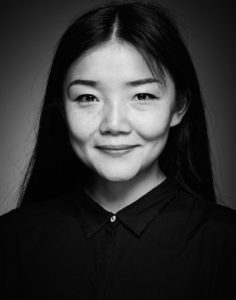
Betsy Damon: [00:14:56] Yeah, every parking lot, every housing complex, everything. Yes. it’s absolutely not done.
Xie Rong: [00:15:05] How did the whole amazing project of the Keepers of the Waters happen in China? How did that unravel?
Betsy Damon: [00:15:19] We don’t have time for the entire story. So, I will cut it short. I was in China in 1989, I was there from May 25th until June 10th. My son and I fell in love with China. I remembered that I had always wanted to go to China, since I was a little girl, really. I knew that if I could swim across the Bosporus in Turkey, I could walk to China. I was six years old.
Sacred Water and Living Water
Betsy Damon: [00:15:59] I did take myself to Japan to study in 1960. But you couldn’t go to China then. So, how to make this a shorter story? Jon did go to China to study at Beida. And I went back with my daughter. We were all in Chengdu through a series of coincidences. I was tapped on the shoulder to speak English with some professors, one of those professors was researching a sacred water site. I discovered that all pristine water sites were considered sacred. The drinking water of every Tibetan village and monastery is a sacred water site. And I think that probably was true in the Buddhist temples and other religious cultures. Much of this has been eradicated.
Betsy Damon: [00:16:59] But there was one site where the professor was researching to discover whether the water had healing properties. I was determined to visit this site. I was awarded a grant and went back and visited this site, which was deep in the mountains. Now you can get there in 6 hours. But back then it was 20 hours of pain. I was giving up my work with water. It was too hard. I had no money left. People in Minnesota didn’t understand the words “living water”. I’d say, let’s make a demonstration of living water. They didn’t say that they didn’t understand me. But in the U.S., we have destroyed every sacred water site, aside from the ones that are actually on reservations.
Betsy Damon: [00:17:58] I went to the sacred site and I drank the water. I could feel it change my body. And I thought, I cannot give up my work. I could almost cry at this moment. I made that decision. This led me to go back to the artists in Chengdu, which was a miracle. Before I returned, I applied for grants and wasn’t successful. After the God Water, I had been at the first environmental conference in Chengdu for the Chinese, not put on by the World Bank, but put on by the Chinese. Their deep knowledge of water inspired me.
Betsy Damon: [00:18:32] And it was a combination of Qi Gong masters and engineers. it was a remarkable conference. And I spoke at the conference a little bit. They were only having the men speak. I had to get up my courage to ask to speak. When I did and I talked about activism, instantly they said: You have to come here. We brainstormed a living water Yangzi project. I won’t go into that whole story, but it was a brilliant project, but it couldn’t possibly happen unless someone gave me half a million dollars in the Chinese too. It involved teaming up the different cities on the Yangzi and the Mississippi. And having each of them from up waters going down to start cleaning projects. It hasn’t begun yet. Maybe it will all start through doing this ideaXme interview.
The Keepers Of The Waters
Betsy Damon: [00:19:29] I received an anonymous phone call from a woman and she gave me $15,000 and my friends raised another $8,000. I went back to Chengdu to direct a Keepers of the Waters project. I went on a tourist visa because I knew that the Chinese government wouldn’t give me a visa if I said it was going to be an activist there.
Betsy Damon: [00:20:03] I went with money in a money belt, on a tourist visa, with an assistant, Kristen Caskey. Over two months, the 12 artists slowly collected. I learned that word of mouth or the underground is very strong in China. The artists came into Chengdu, from Shanghai, Beijing, Lhasa, and other places. They had to learn the history of Sichuan and the water projects and the biology of the river, and then they made art. The artists developed their own ideas and collaborations. Everybody had to talk about their projects and figure out how to share the money. I don’t curate. That was a big steppingstone. People had to get to know each other. And at that time, nobody would say hello to each other. If they didn’t know you, they didn’t say hello. I said to them: You know, it’s very interesting. You come to your meetings, you’re very polite, you sit down, you listen. But you never do what I ask you. You don’t introduce yourself to each other and you don’t say hello and you don’t say goodbye. I said: In the United States, we say hello.
Betsy Damon: [00:21:33] We give a big hug. I think that I exaggerated. Then I demonstrated “a hug hello!”. Everybody started laughing and we laughed and we “hugged hello” for two hours. My son, who was there, said: What about me? And the whole thing continued. After that everybody said hello, and ate together, and got to know each other, and listened to each other and helped each other.
Betsy Damon: [00:22:07] And we went on outings. It was up to them how they spent $7,000 to make art and they made twenty-five pieces. It was fantastic. And the whole time we were watched.
Xie Rong: [00:22:33] I accidentally came across one of the installations and saw children washing the ice (ice blocks from sewage water).
Betsy Damon: [00:22:37] The ices blocks that you came across were formed from the sewer water. The older people scolded the artists, saying that they were wasting the ice, that they could take it to cool their places.
Betsy Damon: [00:22:51] The younger children wanted to eat it. So, we always had a guard there. Poetry started happening at that spot. It was a perfect ecological piece, right? It just melted anddisappeared. Some of those pieces were brilliant. Just brilliant. Sometimes, I mean, the thing that amazed me about the Chinese artist was how direct they were. No, American would have made ice out of polluted water. Few Americans would have stepped into a river and participated in washing silk. This piece was initiated by an American.
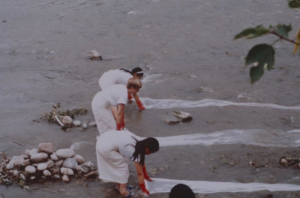
Betsy Damon: [00:23:35] The mirror thing (another installation) was something I thought about and Yin Shir Jin figured out how to do it. Using many ducks with signs communicated a lot about water.
Xie Rong: [00:23:57] There was a lot of audience interaction.
Betsy Damon: [00:24:05] There was a bulletin board, you know, and the leader in China signed that board. There were hours and hours of stories.
Xie Rong: [00:24:21] In the following year, in 1996, you moved the event to Lhasa.
Betsy Damon: [00:24:26] I illegally hitchhiked to Tibet. I said let’s meet some artists. So, then we paid the airfare for them to come down to Chengdu and join us and they said come to Lhasa. I got a Bush Artist Award and went there the next year. We had also started designing the Living Water Garden because the government came and asked me to see their plans for the river when we were doing all this, and we had no permission yet. I met them underneath the old pagoda on Xin Tai Lu Street. It’s a big reconstruction of an old street on the Funan rivers on the confluence in the north. On this pavement there they showed me their plans for all their parks systems. I said to them: Why don’t you make a park to teach people how nature can clean water? And they said to me: Can YOU do that? And I said: Yes! And they said: We would like you to do that.
Betsy Damon: [00:26:00] But they asked me not to do the performances. And I said: I’ll give you my answer in the morning. So, I went back to, to the guest house at the medical college. We were sleeping in a small room with a tiny air conditioner on the floor. We had limited funds. Everybody had the same amount of money. I didn’t live better than anybody else. I said to myself: I can do my dream. I was jumping up and down. Then I thought: No, we have to finish this. I told them that I got the money to do these performances. That it would be too wrong to not finish this, and they told me they were very disappointed that performance art was a waste of time and money, and we will watch it very carefully. And if we like it, we’ll ask you back.
Betsy Damon: [00:27:12] To my joy, they did! They stood on the shores of the river and clapped their hands.
Xie Rong: [00:27:22] It was greatly celebrated by the general public, media and the government. It was a massive show in Chengdu, and it became known internationally. There was a lot of media coverage for example, in Beijing you were on CCTV. It was both national news in China and covered by the world’s media.
Xie Rong: [00:27:39] And so many of the Chinese artists involved are now internationally celebrated. At the time, it was a ground-breaking moment for those artists, for the Chinese people and everyone involved.
Betsy Damon: [00:28:19] Some people did fantastic work with local artists.
Xie Rong: [00:28:24] Like Wang Du who through the event completely changed the situation for Chengdu performance artists. He continued Keepers of the Waters in 1998, 1999 and 2000. So, for him it was a real art moment. It was an art history moment. Was that the goal for you or, was it something else? What did/does it mean to you?
Betsy Damon: [00:29:03] For me, they were definitely moments of change. It was equal to getting out into the streets as a 7,000-Year-Old Woman or equal to building that park. What I learned from how the Chinese could collaborate, the multidimensional aspects of all the work. I had tried to do something similar in northern Minnesota. It was good, but it didn’t go anywhere particularly. It was in large part due to the passion and love of land that the Chinese have, because they have lived on that land for thousands of years, or the Tibetans who have lived up there for thousands of years now. Compare that to most of the people, the people have lived on my land, this land that isn’t my land would be the indigenous people. They have no such publicvehicle for expression until recently. There are indigenous people doing amazing things, but, you know,these things are not integrated into the larger society because the consciousness of America is to exploit. Very few people dare to trespass into a mine or work with a poisoned river. Additionally, we have a small population on a lot of land, which we exploit constantly.And the Chinese knowledge of their land is so deep, and the love of their land is so profound. I think that’s in all that work.
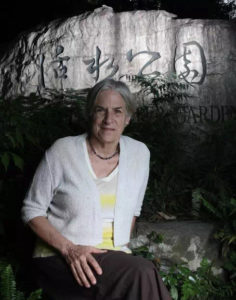
Xie Rong: [00:31:09] Yeah, so could you tell us a bit more about this Living Water Garden? Where did these words “living water” come from?
Betsy Damon: [00:31:25] It’s from Theodor Schwenk, the Max-Planck Institute. “Living water” is water that’s very healthy, very alive with microbes, because that’s what we need. And tap water (processed water) is water that’s been super processed and there are no microbes. So, living water pulses with life, and that’s the pulse of life. That’s why that park is so successful, all the elements in the park are connected and they form certain areas, increasing the pulse.
Betsy Damon: [00:32:08] It could be more, but it’s the start of modelling the pulse, but no matter what they did to that park and there are many others who wanted to destroy it. It still works after twenty-five years. There have been people who want to destroy it and there are people who didn’t even understand it. The government of Chengdu called me back one time and then I sat for 10 hours explaining years after I’d finished it. I didn’t even know they didn’t understand. Now, the Olympic Forest Park in Beijing is wrongly done because the sections of it are not connected. This is what happens in most of the parks anywhere. This is to control the water in the fountain. The systems are not connected so not alive.
Betsy Damon: [00:33:01] They’re disconnected for ‘some kind of idea’ of control. One interesting thing about China is if there’s a good idea, they all do it as in the case of Sponge Cities. I did one of the first workshops for Sponge Cities. I visited some successes. But as relates to water transfer like dams: No, stop creating dams -everywhere in the world, stop! Whether it’s China or the United States or wherever it is: Stop! Source the water that’s yours. Catch the rainwater. I learned that in India. You have to provide the infrastructure for rainwater capture and the recycling of all the water you use inside the big apartment buildings except the blackwater that goes down your toilet.
Xie Rong: [00:34:02] And there was Pittsburgh.
Betsy Damon: [00:34:03] Yep, that project progressed well and then corruption and the superstructure took over and just demolished the project. They misused the money. They didn’t want the poorest community in Pittsburgh to have the first park driven by recaptured and cleaned water. They didn’t want that, and neither did the foundations. So, America is no different than anywhere else. I had not realized until that point the depth of control that happens in my country.
Madness Of Trading The Precious Resource Of Water
Betsy Damon: [00:34:43] At the same time, we all share this earth. We all share the water and everything on this earth. We all need to partner with each other and with nature! We must. The only right thing is that everybody survives. The rich people are buying up the right to water. How can this be right? How can they buy up the right to life?
Betsy Damon: [00:35:47] What’s that? How can you in any conscience buy up the right to life?
Betsy Damon: [00:35:55] There are many things that happen that are incorrect. Look at water bottling. If you really think logically about water bottling, it’s genocide.
Betsy Damon: [00:36:11] So what’s the alternative? The alternative is to clean our own water. Have a good public supply of water everywhere, even where the poorest people live. At least have a good supply of water.
Betsy Damon: [00:36:30] If you think water should be priced, then I suggest that everyone gets, 40 litres of water free of charge and maybe the rest you pay for. The people who use a lot of water should pay a lot more.
Betsy Damon: [00:36:47] Not like California, where the wealthy people who use a lot of water, don’t pay a dime more than the poor people.
Betsy Damon: [00:36:55] Let’s really think about how to have equity in and our life sustaining systems. Water is so incredible, beyond what we understand. Scientists have only just begun to understand. Ok, it’s almost a cliche. There’s no life without water. But do we think that you know that every day I take a walk, I eat a meal, I should say: Thank you, water! Do we think about that? No, we really don’t think about that. Who is the ruler of our life? What’s the ruler of our life? The ruler of our life is water. And good air.
Betsy Damon: [00:37:47] And air is dependent on the trees and the water. It is all connected. We are all connected. How do we get this back into our brains? I love it that Roots and Shoots is in the Living Water Garden now in Chengdu. You know, Roots and Shoots is worldwide. And Jane Goodall is amazing. But really, what I’m talking about is not that hard.
Betsy Damon: [00:38:22] I’m not talking about building a rocket or even an automobile.
Xie Rong: [00:38:27] Even on your website, you have sketches for people to learn how to capture rainwater from their back gardens.
Betsy Damon: [00:38:37] That’s right. All of this is information is already accessible for example, in books. If you go to any group of people who are farmers, they all have the information/answers: How do I keep this river clean? How do I do these things? And it’s, again, not rocket science. Number one stop polluting it. You have to really pollute to make water dirty because water will always clean to its highest state. You have to be determined to destroy it. So I urge people, collaborate if you’re one of ten factories on a lake, get together and decide to clean it up. Don’t say: Not me! Everyone needs to take responsibility. It’s all of you. You know, they took all the drinking water fountains out because Nestle did a campaign to try and intimidate the people in Detroit that their water was dirty, and they were bottling the same drinking water.
[00:39:53] Every community, just get out your maps. Look at where the waters are and where they come from and where they flow. What I am saying is all in my new book. It’s actually in a book, including a model workshop.Xie Rong: [00:40:14] What is the book called?
Water Talks
Betsy Damon: [00:40:14] It is called Water Talks and it’s not published yet. I’m hoping it will be published by next Spring or latest Summer. It includes guideposts that people can adapt for their own cultures and communities.
Xie Rong: [00:40:59] It’s been wonderful listening to you. Before conducting this interview, I saw many images of your work and read a great deal about your projects. Listening to you telling your story today has meant so much me.
What Can We Learn From Water?
Xie Rong: [00:41:17] It was very clear to you in 1985 when you looked at the riverbed and then up at the Milky Way how water was at the centre of everything, connects everything. But perhaps 2020, is the first time for a lot of people to actually realize the extent to which we are interconnected with nature (part of nature) and reliant on each other to survive and flourish. We are in this world together, all on this planet together. What do you think we can learn from water to address this current crisis? Do you think water can help teach and help heal us in this COVID-19 crisis?
Betsy Damon: [00:42:08] I don’t have any doubt that water is the healer. That when we really know water, we could probably heal everything. It’s an ancient saying or truth in China, that if the person who’s fortunate enough to live next to very high-quality water they can become so healthy, they can see the illness clearly. They can think clearly. I feel it’s almost like what happened to me when I drank the God water. I suddenly could see very clearly. In this crisis, I think the paramount thing is to understand our responsibilities to all the people around us.
Betsy Damon: [00:42:59] Now, that’s why you wear a mask. That’s why you’re careful. You wouldn’t want your family or people you love to get this, and apparently, it’s not so clear who spreads and who doesn’t spread? That’s scary. The crisis is going to fade. However, there’s going to be another one unless we change.
Betsy Damon: [00:43:25] I grew up when polio was communicable and had relatives that were, crippled by polio. I probably have a slightly different take on that, than maybe your generation, so this is hard, it’s hard work. In my country, people are used to instant gratification, instant entertainment. They’re not used to resourcing themselves in the way, say, my parents’ generation or my grandparent’s generation, where you stay at home. But the bigger crisis is the planet. And partly we have this COVID-19 because there’s not enough strong biosystems left. More and more viruses are going to jump out into us. That isn’t talked about yet and that needs to be talked about. We have to restore the bio dynamism of this planet.
Betsy Damon: [00:44:49] It doesn’t mean less people. It just means we change how we do things. Americans throw away 30 percent of all their food. When I lived in China, I generated one little bag of garbage a week. When I live here, I generate four bags of garbage. We need to stop puttingpoisons into everything. I’ve been on college campuses here that are funded by Dow Chemical that use so many chemicals on the lawn that you never see birds.
Betsy Damon: [00:45:35] I know that Harvard voted to not be energy neutral. It’s board of directors were not in favour, when the entire faculty voted to have it. So, everyone needs to get on board. In China they’ve done a lot of planting of trees and in India more.
Betsy Damon: [00:46:06] I happen to know that China built a great many dams in the last 20 years. Take them down! Don’t dam all your mountains. I went to some of the purest places in China. They were starting to build the dams. And these places were so buzzing with life.
Xie Rong: [00:46:38] You are making a documentary with a Tibetan filmmaker?
Betsy Damon: [00:46:42] That’s right. We haven’t finished (laughs). No chance, no money.
Betsy Damon: [00:46:49] And if I did have the money that I would like to have, I would fund a lot of start-up projects and create a mapping so everybody could talk to each other. So, they could ask: How do I do this? How do I do that?
[00:47:08] If I had the way to do that and, there would be a person running it and then if somebody said, OK, we need $10,000 to get started here, that’s not a lot of money, but I don’t have even a few thousand anymore to have that kind of situation.Betsy Damon: [00:47:29] For several people in Africa who have written to me, that’s all they need. They don’t need that much. But instead of saying: Ok, we’re going to fund people clean drinking sources. People need a livelihood on the ground. They don’t need a last minute, one rescue program. They need a real livelihood collecting rainwater so that the gardening can work, recycling everything, including their pee and shit, because that’s a great and wonderful resource. This is a relationship with the natural world that could you know if done properly ensure that people everywhere can thrive. It’s not hard. That would be my dream.
Betsy Damon: [00:48:39] And then you have a small group of very knowledgeable people who can help out. Then they end up helping each other. I know if you do one thing in a village up in the mountains, the other villagers all learn.
Xie Rong: [00:48:55] On that note, thank you so much. It has really been wonderful talking with you. It has enriched my personal knowledge. I’m sure our audience will have enjoyed your stories and dreams. Hopefully, they have been inspired to participate in your initiatives to become the Keepers of the Waters. I would now like to share a video with you from China (please check out the video on YouTube). It is a message from an old friend.
[00:49:23] Note: At the end of the ideaXme interview one of the participants in the Keepers of the Waters project in China thanks Betsy for her work. The video has subtitles and can be found on ideaXme’s YouTube and Vimeo channels.Credits: Xie Rong, ideaXme Eco Art Ambassador.
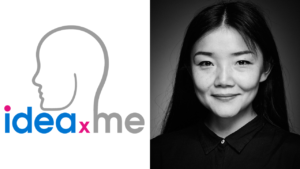
If you enjoyed this interview please check out ideaXme’s interview with Virginijus Sinkevičius, European Commissioner for the Environment.
Follow ideaXme on Twitter: @ideaxm
On Instagram: @ideaxme
Follow Xie Rong on Instagram: @echomorgan Twitter: @xierongart
Find ideaXme across the internet including on iTunes, SoundCloud, Radio Public, TuneIn Radio, I Heart Radio, YouTube, Vimeo, Google Podcasts, Spotify and more.
ideaXme is a global podcast, creator series and mentor programme. Our mission: Move the human story forward!™ ideaXme Ltd.

